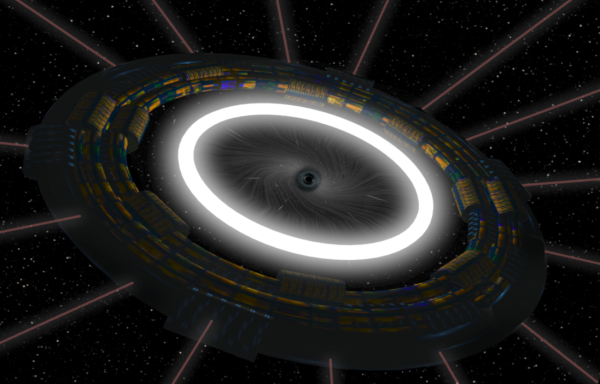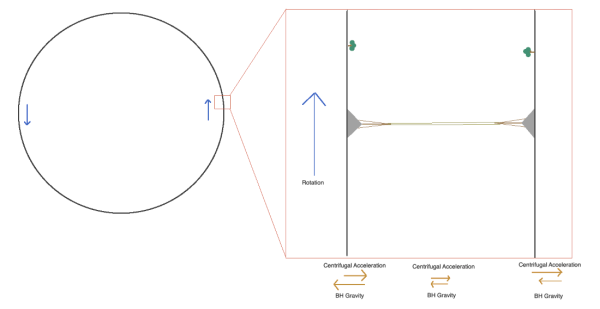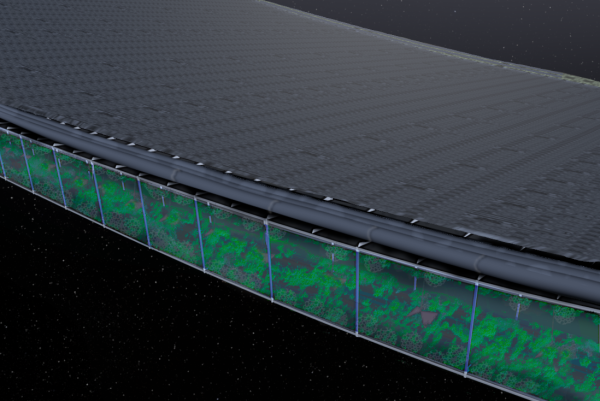BY LETTER
Penrose Place
Technology > Application > Megascale Engineering
Galactography > Minor Polities > Refugium Federation
Galactography > Systems and Worlds > Systems & Worlds O - P
Galactography > Minor Polities > Refugium Federation
Galactography > Systems and Worlds > Systems & Worlds O - P
Stellar black hole with inhabited megastructures | |
 Image from Steve Bowers | |
| The BZ Generator Ring, a megastructure with a radius of 6000km, surrounds the black hole and extracts energy from the hole's rotation via the process; this energy is sent to the habitable megastructures (and other locations) via particle beam | |
DATA PANEL : Penrose Place | |
| System | Penrose Place |
|---|---|
| Primary | A rotating stellar-mass black hole |
| Mass | 1.15 x 10^31kg (5.75 x Msol) |
| Spin Parameter | 0.26 |
| Schwarzchild radius | 16.98km |
| Event horizon radius at equator | 16.69km |
| Ergosphere radius at equator | 19.98km |
| Distance from Sol | 2210 ly |
| Constellation | Centaurus |
| Infrastructure | -The BZ Generator Ring surrounds the black hole at a radius of 6000km, at times expanding to 8000km to store excess angular momentum. It extracts rotational energy from the black hole's ergosphere and transmits that energy to the rest of the system. -Two tidal habitat rings surround the black hole at radii of 44 000 km and 500 000 km. |
|---|---|
| Population | 160 billion |
| Travel | 3 beamrider links. 8 lightway links. The nearest wormhole-connected system is Rorchance, 24 lightyears distant. |
DATA PANEL: TIDAL HABITAT RINGS | |
| Inner Ring | Radius: 44 000km Width: 800km Thickness: 800m Orbital Speed: 4165 km/s (87 x Mercury, 0.014c) Orbital Period: 66.34 seconds Surface acceleration: 0.73g Surface area: 2.2 x 10^8 km^2 (0.43 x Earth) |
|---|---|
| Outer Ring | Radius: 500 000km Width: 1200km Thickness: 2000km Orbital Speed: 1235 km/s (26 x Mercury, 0.004c) Orbital Period: 2542.5 seconds / 42.375 minutes Surface acceleration: 0.7g Surface area: 5 x 10^10 km^2 (100 x Earth) Pressurised freefall volume: 6.28 x 10^10 km^3 All orbital values are as seen by an observer at infinity. Relativistic corrections are negligible, less than 0.2% |
Overview and History
Penrose Place would generally be considered to have low potential for colonisation due to limited available matter. Lacking a stellar companion or accretion disk, the only nearby source of matter was a lone terrestrial planet in a distant orbit.However, for the growing Refugium Federation, this same quality, rendering it extremely difficult to detect from a distance, made it an ideal location. After a peaceful political schism in a nearby red dwarf member system, a group of nearbaseline human and provolve colonists set out towards the system, arriving in 5902. Using matter from the planet, they constructed several small habitats as well as the initial components of the BZ generator to extract energy from the black hole's rotation.
Over the next two centuries, the local culture mutated slowly, with the original quasi-hider values being replaced by a growing appreciation for extravagant engineering. A proposal to build a tidal ring habitat around the central black hole, eventually gained the support of a majority of the population in 6125.
Construction of the first habitat took place over the next four centuries, during which time there were further shifts in the local culture. By the time the inner ring was completed in 6540, most of its inhabitants chose to adopt a quasi-neolithic lifestyle on its habitable surface. A minority remained interested in megascale engineering. Ceding the inner ring to their compatriots, they chose to build a second, larger ring using the experience they had gained from their first effort.
With the local culture thus preoccupied, it was barely troubled by recontact with the rest of Terragen civilisation. Nevertheless, when the outer tidal habitat ring was completed in 7200, an opening up of communications had generated a further cultural shift, with many of the inhabitants coming to value social diversity and ongoing change. The outer ring therefore came to be inhabited by a wide variety of societies, which quickly became formalised as the Culturotype Neighbourhoods.
The resulting dual cultures of Penrose Place turned out to be highly stable, providing enough diversity between them to inhibit further cultural shifts, but retaining a sense of overall unity provided by their unusual environment. They have retained their present form up until the present day, and show no signs of changing in the near future.
Penrose Place is still a member of the Refugium Federation, but it stands somewhat aloof from the other members, being neither entirely inward-looking, nor enamoured with cultural changes in the rest of the galaxy.
The BZ Generator
Penrose Place is built around a rotating, stellar-mass black hole, using the singularity's rotation as its energy source.The BZ Generator is a complex of superconducting cables, mass beams, and plasma surrounding the black hole at a radius of 6000km. It extracts energy from the black hole's ergosphere using an artificial analogue of the Blandford-Znajek process: Electric currents in the superconducting cables and plasma generate a poloidal magnetic field that passes through the ergosphere. Because the magnetic field lines inside the ergosphere must rotate with the black hole, they transfer angular momentum (and thus rotational energy) to the plasma and superconducting cables of the BZ generator.
It is necessary to manage the angular momentum extracted from the black hole. In the short term, the BZ generator itself serves as a buffer: It is capable of expanding its orbital radius by up to 2000 km to store excess angular momentum. Over the longer term, it imparts angular momentum and energy via mass beams to the tidal habitat rings, which in turn send mass beams to beamrider stations in the outer system. Outgoing and incoming beamriders can then safely absorb the excess angular momentum.
The Tidal Habitat Rings
 Image from Liam Jones | |
| Tidal gravity in the two habitable rings of the Penrose Place system is provided by tidal effects, so that each ring has both an inner surface and an outer surface with a local gravitation of around 0.7 gees | |
Two megastructure rings surround the black hole, using tidal forces to generate gravity on their interior surfaces. Each ring rotates at orbital speed, such that its centrifugal acceleration and the black hole's gravity balance. In the central region between the two surfaces, the balance is perfect, resulting in freefall conditions. However, each ring's lower surface is closer to the black hole. Here, the black hole's gravity is stronger than the ring's centrifugal acceleration, so the lower surface experiences a net gravitational acceleration pointing inward. Conversely, the ring's upper surface is further away from the black hole. Here, the black hole's gravity is weaker than the ring's centrifugal acceleration, so the upper surface experiences a net acceleration away from the black hole.
Inner Ring
 Image from Steve Bowers | |
| The Inner Ring, with tidal gravity effects creating a habitable surface in both directions (towards the black hole and away from it) | |
The Inner Ring orbits at a radius of 44 000 km and is only 800m thick, with each surface experiencing a gravity of 0.73g. It is 800km wide, giving a total surface area of 2.2 * 10^8 km ^2. Because the ring is so thin, the entire interior volume is filled with air, with a freefall environment between the two surfaces. A grid of optical phased-array membranes in the centre projects sunlight onto the two surfaces. Diamondoid viewing windows are spread across the lower surface, each a kilometre wide, spaced at intervals of 10km, through which the inhabitants can see the central black hole.
The inhabitants of the Inner Ring have a quasi-primitive culture. They live in nomadic bands or small villages, producing most goods using a limited number of simple techniques, but have backups, perfect health, and access to in-system transport if needed. The local plants provide ample, easily-obtainable food and resources, and the environments are tuned to provide optimal comfort.
Nearbaseline humans have social structures modelled after those of their palaeolithic and neolithic ancestors, while provolves have various suitable analogues. Sapient hyenas live in matriarchal clans on the great plains, solitary Mawas carve out territories in the forests, and densely-populated communities of Eudore live in ocean burrows below Madi cleaning stations.
The inhabitants frequently build connections between the two surfaces by hand. A group on one surface signal their intention by starting to construct a stone pyramid; then a group on the other surface can respond by building another pyramid directly above/below the first. When each pyramid is finished, usually reaching a height of around 120 metres, it is topped by a wooden framework spire, reaching to a total height of around 300 metres. At this height, the local gravity is only 0.18g, and stones trailing narrow ropes can be fired from one spire to the other. Once a pilot rope has connected the spires, it is expanded into a stronger framework, allowing inhabitants from each surface to travel to the other. This final connection, accomplished after several years of work, is a cause for great celebration between the two groups.
Outer Ring
The Outer Ring orbits at a radius of 500,000 km and is 1200 km thick, with each surface experiencing a gravity of 0.7g. Each surface has 4 vertical levels spaced 10 km apart, giving 8 levels in total. The Ring is 2000km wide, giving a total surface area of 5 * 10^10 km^2. In the middle of the outer ring, two transparent membranes 10 km apart hold a breathable freefall atmosphere.The Outer Ring is divided into thousands of Culturotype Neighbourhoods. Each Neighbourhood occupies a cylindrical cross section through the ring, consisting of a circular region 100km across on each of the eight levels and in the freefall space between them. The Neighbourhoods are arranged in a hexagonal packing across the ring's surface, with communal spaces between them.
Each Neighbourhood has a particular theme that determines the architecture, social structure, and lifestyles of the sophonts living in it. Currently only a third of the Outer Ring is inhabited. New Culturotype Neighbourhoods emerge at the edges. Their themes are chosen at random from dictionaries in various languages, and the first inhabitants to move in decide how to enact that theme. Neighbourhoods that don't attract enough inhabitants, or lose most of their current inhabitants, are decommissioned so a new theme can be chosen. Some of the more famous and long-lived include:
-Stage, which is oriented around the performing arts. The average citizen spends one third of their time performing, one third of their time writing, and one third of their time watching others. Even small towns have dozens of theatrical spaces of varying sizes, holding all manner of narrative, musical, comedic, dance, puppetry, prestidigital, and other types of performances. On the Great Stages, each the size of a city, epics with thousands of characters and containing numerous recursive sub-performances are acted and transmitted live across the Outer Ring. Even ordinary social interaction often consists of freestyle poetic diction.
-Urgent, which is based around time limits. All activities come with a time limit and a priority ranking, though citizens will often challenge each other to be even faster. Failing to meet deadlines too often usually results in expulsion from the Neighbourhood. Urgent tends to use archaic construction methods that can more easily be rushed while still being accessible to embodied modosophonts, but its cities are in constant flux, as the buildings have limited lifespans.
-Intrigue's politics are based around several groups making and breaking alliances, while the members of each group vie for supremacy. Occasionally a single group achieves dominance before internal power struggles cause it to splinter. Intrigue tends to cycle between ordered and anomie phases: During the former, citizens tend to strive for legal, bureaucratic, or social control. During the latter, citizens assassinate each other. Continuous backups ensure this practice is safe, but assassinated citizens are expelled from the Neighbourhood until the next period of order.
-Polyhedra has strict mathematical rules for the shapes of everything from buildings to clothes. Its greatest city, located in the freefall band, is the Final Stellation of the Icosahedron. Its constituent buildings are divided into four different functions, with the function determining whether they are Platonic, Archimedean, Catalan, or Johnson solids, and the position determining which specific solid they are within those groups.
Related Articles
Appears in Topics
Development Notes
Text by Liam Jones
Initially published on 16 October 2024.
Initially published on 16 October 2024.
Additional Information






